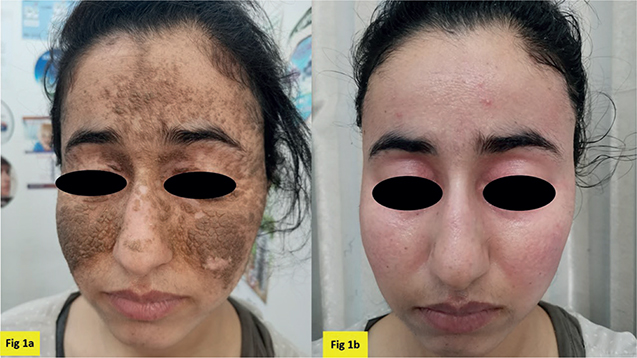QUIZ SECTION
A Cornflake-like Dermatitis: A Quiz
Marwa THABOUTI1, Nadia GHARIANI FETOUI1, Badreddine SRIHA2, Colandane BELAJOUZA1 and Mohamed DENGUEZLI1
1Dermatology and 2Anatomopathology Department, Farhat Hached Hospital, Sahloul 1, Sousse, Tunisia. E-mail: hebek2011@live.com
Citation: Acta Derm Venereol 2023; 103: adv00894. DOI https://doi.org/10.2340/actadv.v103.6515.
Copyright: © Published by Medical Journals Sweden, on behalf of the Society for Publication of Acta Dermato-Venereologica. This is an Open Access article distributed under the terms of the Creative Commons Attribution-NonCommercial 4.0 International License (https://creativecommons.org/licenses/by-nc/4.0/)
Published: Mar 20, 2023
A woman in her 20s, with no pathological history, presented with brown and verrucous plaques, which had developed over a period of 3 years, on her face. Physical examination revealed thick, yellow-brown, hyperkeratotic plaques, which were easily detachable (Fig. 1a). Mucosal examination identified severe periodontitis with a lack of oral hygiene. Face cleaning was performed during the consultation, using alcohol gauze. The debris were removed, and the lesions disappeared revealing an erythematous and shiny skin (Fig 1b).

Fig. 1. (a) Thick, yellow-brown and hyperkeratotic plaques, easily detachable. (b) Face cleaning revealed an erythematous and shiny skin. Permission given by the patient to publish these photos.
What is your diagnosis? See next page for answer.
A Cornflake-like Dermatitis: A Commentary
Diagnosis: Dermatitis neglecta
Dermatitis neglecta (DN) or unwashed dermatosis is a rare condition. It arises from inadequate frictional cleansing. The accumulation of sebum, sweat, keratin and other dirt results in the development of hyperpigmented, verrucous plaques with adherent cornflake-like scales. DN should be recognized early to avoid aggressive diagnostic and therapeutic procedures. The diagnosis is clinical, and lesions can be identified by removing the crusts with isopropyl alcohol. Biopsy is not necessary for the diagnosis, but, if done, it shows keratin lamella dissociated with mycotic spores, hyperkeratosis and papillomatosis in the epidermis, with a lymphocytic dermal infiltrate (2). This condition has been described in cases with poor cleanliness due to hyperaesthesia, trauma or disability, but also with mental illnesses. Stein et al. (3) classified DN as an impulsive aggressive type of obsessive-compulsive disorder. Thomas et al. (4) reported cases of DN associated with psychiatric and neurological instabilities, such as apathy, cognitive difficulties, but also with vitamin and micronutrient deficiencies. Paramjeet et al. (5) reported a case of DN associated with undifferentiated schizophrenia. In the current case, DN revealed a factitious disorder, which is a serious mental disorder in which a person acts as if suffering from a physical condition, when in fact they themselves have created the symptoms, motivated purely by internal gains, such as a desire for attention or coping with stress. DN is not a benign condition, and is associated with increased morbidity and mortality. Its exact aetiology is not known; researchers suggest that a history of abuse or neglect as a child may be factors in the pathogenesis of the disorder (6). The current patient had an unstable personality, based on falsification of medical symptoms without clear gain. She repeatedly acted in a very aggressive and hostile manner towards the consultant in charge of treatment whenever confronted with the diagnosis of FD, claiming that it was a wrong diagnosis and that she was only physically unwell. She was eventually lost to follow-up. The main differential diagnoses of DN are terra firma-form dermatosis, confluent reticulated papillomatosis of Gourgeot and Carteaud, acanthosis nigricans, verrucous naevi and Darier’s disease. Treatment is based on psychotherapy. To the best of our knowledge, this is the first case report of DN with an underlying factitious disorder; more investigations are needed to explain the relationship between these 2 conditions.
DN is an asymptomatic, but cosmetically debilitating, condition. It is rare, and is likely to be misdiagnosed, and should be recognized early to avoid aggressive diagnostic and therapeutic procedures. Its association with mental health conditions is described in the literature (3, 4). In the current case, the patient had DN, revealing a FD without psychosocial support.
REFERENCES
- Poskitt L, Wayte J, Wojnarowska F, Wilkinson JD. ‘Dermatitis neglecta’: unwashed dermatosis. Br J Dermatol 1995; 132: 827–839.
- Richter LL, Miller RM, Hillman JD, Chiu MW. Bilateral thick crusts on the legs. Int J Dermatol 2013; 52: 133–135.
- Stein I, Hollander E. Dermatology conditions related to obsessive compulsive disorder. J Am Acad Dermatol 1992; 26: 237–242
- Brown TM. Dermatitis neglecta, the cognitive assessment, and micronutrients. Psychosomatics 2020; 61: 723–726
- Singh P, Kar SK, Kumari R, Gupta SK. Dermatosis neglecta in schizophrenia: a rare case report. Indian J Psychol Med 2015; 37: 93–95.
- Carnahan KT, Jha A. Factitious disorder. Treasure Island, FL: StatPearls Publishing; 2021 Jan.